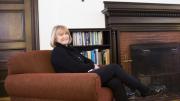Following the decisive moment tradition of Henri Cartier-Bresson, Carlin Wing 02 started out doing New York street photography in high school. One day in a supermarket, she got yelled at for taking pictures without the subjects permission. How do you take street photos and ask permission? she wondered. Asking permission ruins it. These questions led Wing to consider the invasive or even exploitative nature of the photograph, with this upshot: I stopped taking pictures of people.
But she didnt stop taking pictures. At Harvard, she pursued a joint concentration in visual and environmental studies (VES) and social anthropology. Photography grew up in the era of colonialism, she explains. It was a way to show the other. For a long time, anthropology was about powerful people going somewhere to study people with less power. I think its also important to study the powerful. You can study corporate culture like any other culture.
As a college junior, Wing began shooting Culture, Inc., a series of photographs of artworks hung in corporate spaces. Unfortunately for photographers, Places of power have the power to control access, says Wing. They dont want anyone else interpreting their image. Large companies like Philip Morris and Fidelity would not let me in. Luckily, she had family connections: both her parents are attorneys, and their law firms granted Wing permission to shoot in their offices. (So far, in fact, all the Culture, Inc. spaces have been law firms.) Corporations buy the majority of artthey have the most wall space. Learning this was a huge shock to me, Wing says. My photographs juxtapose high art and corporate environments in a way that stands as a metaphor for the relationship between the two.
 |
 |
| Two photographs from Carlin Wing's series Culture, Inc. depict interiors at law firms. |
| Courtesy of Carlin Wing |
A top varsity squash player at Harvard, Wing moved to Amsterdam after college and played a couple of years of professional squash on the international circuit. Returning to Cambridge in 2004, she worked as a teaching assistant in VES, and continues competitive squash. (One of her new projects involves shooting glass-walled squash courts at different tournament venues.) Last year, she was one of eight young American photographers included in an international group show, reGeneration: 50 Photographers of Tomorrow.
Wing is now a graduate student in photography and media at the California Institute of the Arts. Her new photo series has progressed upward, from shooting walls to shooting ceilings. Ceilings, she reports, are much less blank than I thought.
~C.L.





